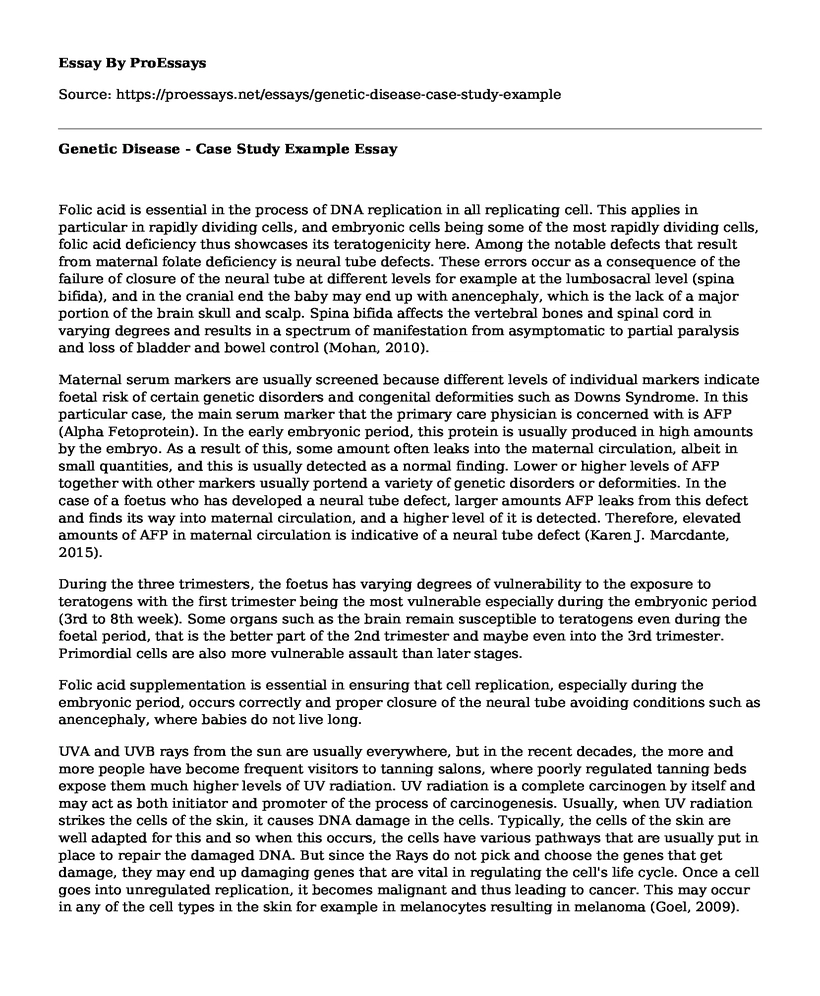Folic acid is essential in the process of DNA replication in all replicating cell. This applies in particular in rapidly dividing cells, and embryonic cells being some of the most rapidly dividing cells, folic acid deficiency thus showcases its teratogenicity here. Among the notable defects that result from maternal folate deficiency is neural tube defects. These errors occur as a consequence of the failure of closure of the neural tube at different levels for example at the lumbosacral level (spina bifida), and in the cranial end the baby may end up with anencephaly, which is the lack of a major portion of the brain skull and scalp. Spina bifida affects the vertebral bones and spinal cord in varying degrees and results in a spectrum of manifestation from asymptomatic to partial paralysis and loss of bladder and bowel control (Mohan, 2010).
Maternal serum markers are usually screened because different levels of individual markers indicate foetal risk of certain genetic disorders and congenital deformities such as Downs Syndrome. In this particular case, the main serum marker that the primary care physician is concerned with is AFP (Alpha Fetoprotein). In the early embryonic period, this protein is usually produced in high amounts by the embryo. As a result of this, some amount often leaks into the maternal circulation, albeit in small quantities, and this is usually detected as a normal finding. Lower or higher levels of AFP together with other markers usually portend a variety of genetic disorders or deformities. In the case of a foetus who has developed a neural tube defect, larger amounts AFP leaks from this defect and finds its way into maternal circulation, and a higher level of it is detected. Therefore, elevated amounts of AFP in maternal circulation is indicative of a neural tube defect (Karen J. Marcdante, 2015).
During the three trimesters, the foetus has varying degrees of vulnerability to the exposure to teratogens with the first trimester being the most vulnerable especially during the embryonic period (3rd to 8th week). Some organs such as the brain remain susceptible to teratogens even during the foetal period, that is the better part of the 2nd trimester and maybe even into the 3rd trimester. Primordial cells are also more vulnerable assault than later stages.
Folic acid supplementation is essential in ensuring that cell replication, especially during the embryonic period, occurs correctly and proper closure of the neural tube avoiding conditions such as anencephaly, where babies do not live long.
UVA and UVB rays from the sun are usually everywhere, but in the recent decades, the more and more people have become frequent visitors to tanning salons, where poorly regulated tanning beds expose them much higher levels of UV radiation. UV radiation is a complete carcinogen by itself and may act as both initiator and promoter of the process of carcinogenesis. Usually, when UV radiation strikes the cells of the skin, it causes DNA damage in the cells. Typically, the cells of the skin are well adapted for this and so when this occurs, the cells have various pathways that are usually put in place to repair the damaged DNA. But since the Rays do not pick and choose the genes that get damage, they may end up damaging genes that are vital in regulating the cell's life cycle. Once a cell goes into unregulated replication, it becomes malignant and thus leading to cancer. This may occur in any of the cell types in the skin for example in melanocytes resulting in melanoma (Goel, 2009).
I would first start by explaining how the prolonged and frequent exposure to such high levels of UV radiations in the tanning beds may cause damage to the DNA in the cells in the skin thereby increasing the risk of developing skin cancers such as melanomas. Once that is understood by the client, I would then advise them to use the tanning bed in moderation or to avoid them altogether.
Yes, the primary care physician would do a skin assessment at this point. This is because the patient may have already developed a malignant lesion and it would be safer to rule it out, because skin malignancy such as melanomas may small enough not to warrant concern from the patient.
References
Goel, K. M. (2009). Hutchison's Paediatrics. UK: Jaypee Brothers.
Karen J. Marcdante, M. (2015). Nelson Essentials of Paediatrics. USA: Elseiver Saunders.
Mohan, H. (2010). Textbook of Pathology. India: Jaypee Brothers Medical Publishers.
Cite this page
Genetic Disease - Case Study Example. (2021, Jun 18). Retrieved from https://proessays.net/essays/genetic-disease-case-study-example
If you are the original author of this essay and no longer wish to have it published on the ProEssays website, please click below to request its removal:
- Essay Sample on Sickness and Wealth
- Is HIPAA Sufficient? Essay Example
- Patient Safety Issues Paper Example
- Patient Care Assistant Paper Example
- Improving Patient Intake Process: Analysis of Theory of Constraints, Murphey's Law and Parkinson's Law
- Patient Safety: Achieving Zero Preventable Deaths - Essay Sample
- Paper Example on COPD: Symptoms, Diagnosis, and Treatment







